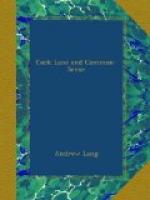One thing in this matter is tolerably certain, namely, that intense religious excitement produces a tendency to believe in marvels of all sorts, and also begets a capacity for being hallucinated, for beholding spectres, strange lights, dubious miracles. Thus every one has heard of the temptation of St. Anthony, and of other early Christian Fathers. They were wont to be surrounded by threatening aspects of wild beasts, which had no real existence. In the same way the early Zulu converts of Bishop Callaway, when they retired to lonely places to pray, were haunted by visionary lions, and phantasms of enemies with assegais. They, probably, had never heard of St. Anthony’s similar experiences, nor, again, of the diabolical attacks on the converts of Catholic missionaries in Cochin China, and in Peru.
Probably the most recent period of general religious excitement in our country was that of the Covenant in Scotland. Not a mere scattered congregation or two, as in the rise of Irvingism, but a vast proportion of a whole people lived lives of prolonged ecstatic prayer, and often neglected food for days. Consequently devout Covenanters, retired in lonely places to pray, were apt to be infested by spectral animals, black dogs as a rule, and they doubted not at all that the black dog was the Accuser of the Brethren. We have Catholic evidence, in Father Piatti’s Life of Father Elphinstone, S. J., to black dogs haunting Thomas Smeaton, the friend of Andrew Melville (1580). But Father Piatti thinks that the dogs were avenging devils, Smeaton being an apostate (MS. Life of Elphinstone). Again Covenanters would see mysterious floods of light, as the heathen also used, but, like the heathen, they were not certain as to whether the light was produced by good or bad spirits. Like poor bewildered Porphyry, many centuries earlier, they found the spirits ‘very deceitful’. You never can depend on them. This is well illustrated by the Rev. Mr. Robert Law, a Covenanting minister, but not a friend of fanaticism and sedition.
In his Memorialls, a work not published till long after his death, he gives this instance of the deceitfulness of sprites. The Rev. Mr. John Shaw, in Ireland, was much troubled by witches, and by ‘cats coming into his chamber and bed’. He died, so did his wife, ‘and, as was supposed, witched’. Before Mr. Shaw’s death his groom, in the stable, saw ’a great heap of hay rolling toward him, and then appeared’ (the hay not the groom) ’in the shape and lykness of a bair. He charges it to appear in human shape, which it did.’ The appearance made a tryst to meet the groom, but Mr. Shaw forbade this tampering with evil in the lykness of a bair. However a stone was thrown at the groom, which he took for a fresh invitation from the bair, so he went to the place appointed. ’The divill appears in human shape, with his heid running down with blood,’ and explains that he is ’the spirit of a murdered man who lay under his bed, and buried in the ground, and who was murdered by such a man, naming him by name’. The groom, very naturally, dug in the spot pointed out by this versatile phantom, ’but finds nothing of bones or anything lyke a grave, and shortly after this man dyes,’ having failed to discover that the person accused of murder had ever existed at all.




